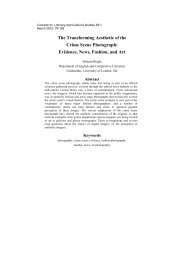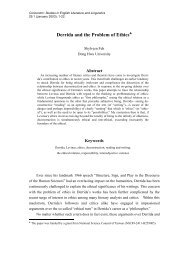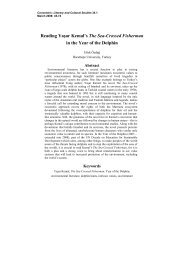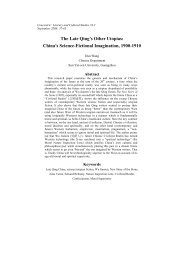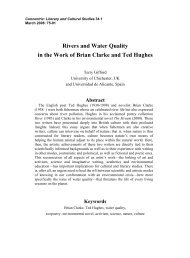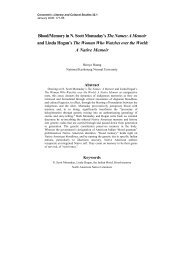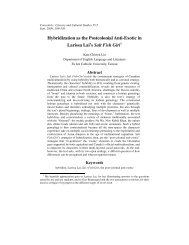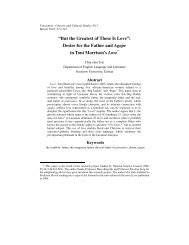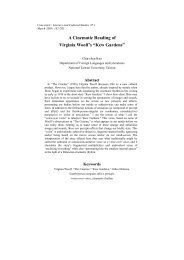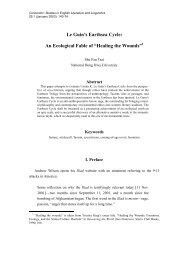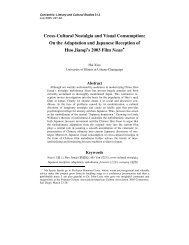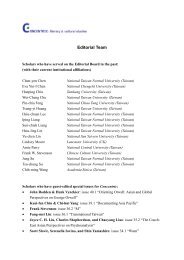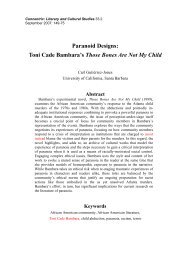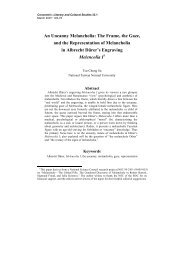The Gaze of the Other in Ang Lee's Crouching Tiger ... - Concentric
The Gaze of the Other in Ang Lee's Crouching Tiger ... - Concentric
The Gaze of the Other in Ang Lee's Crouching Tiger ... - Concentric
You also want an ePaper? Increase the reach of your titles
YUMPU automatically turns print PDFs into web optimized ePapers that Google loves.
191<br />
Tsai: Crouch<strong>in</strong>g <strong>Tiger</strong> and <strong>The</strong> Birds<br />
character with<strong>in</strong> <strong>the</strong> dream) and looks at what “he” (or “she”) is look<strong>in</strong>g at. Lacan later<br />
expla<strong>in</strong>s that this formulation captures <strong>the</strong> notion that “<strong>the</strong> consciousness, <strong>in</strong> its<br />
illusion <strong>of</strong> see<strong>in</strong>g itself see<strong>in</strong>g itself, f<strong>in</strong>ds its basis <strong>in</strong> <strong>the</strong> <strong>in</strong>side-out structure <strong>of</strong> <strong>the</strong><br />
gaze” (82). Thus self and o<strong>the</strong>r <strong>in</strong> <strong>the</strong> Cartesian “I th<strong>in</strong>k” becomes <strong>the</strong> problem <strong>of</strong> <strong>the</strong><br />
eye and <strong>the</strong> gaze—“See<strong>in</strong>g itself see<strong>in</strong>g itself.” In <strong>the</strong> scopic field <strong>the</strong> o<strong>the</strong>r is always<br />
already backgrounded, and <strong>the</strong> gaze is always imag<strong>in</strong>ed, for <strong>the</strong> human eye is<br />
disrupted by <strong>the</strong> gaze <strong>of</strong> <strong>the</strong> O<strong>the</strong>r: <strong>the</strong> relationship between <strong>the</strong> eye and <strong>the</strong> gaze, like<br />
<strong>the</strong> relationship between self and o<strong>the</strong>r, is <strong>in</strong>teractive, mutually implicated; <strong>the</strong>y are<br />
contradictory yet complementary. Thus Lacan asks: “Where is <strong>the</strong> background? Is it<br />
absent? No. Rupture, split, <strong>the</strong> stroke <strong>of</strong> <strong>the</strong> open<strong>in</strong>g makes absence emerge—just as<br />
<strong>the</strong> cry does not stand out aga<strong>in</strong>st a background <strong>of</strong> silence but on <strong>the</strong> contrary makes<br />
<strong>the</strong> silence emerge as silence” (26). And so <strong>the</strong> birds <strong>in</strong> Hitchcock’s <strong>The</strong> Birds always<br />
lurch <strong>in</strong> <strong>the</strong> background as “o<strong>the</strong>rs”: <strong>the</strong>y are ourselves “oversee<strong>in</strong>g” ourselves (as<br />
superego), Horwitz’s “agents <strong>of</strong> surveillance” seen now as an <strong>in</strong>verted <strong>in</strong>ter- subjective<br />
and <strong>in</strong>tra-subjective gaze, culture gazed down upon by a nature that has itself already<br />
become <strong>the</strong> <strong>in</strong>verted gaze <strong>of</strong> culture.<br />
In <strong>Ang</strong> Lee’s Crouch<strong>in</strong>g <strong>Tiger</strong>, Hidden Dragon we get no birds attack<strong>in</strong>g from<br />
above but humans (“named” as tigers and dragons) attack<strong>in</strong>g one ano<strong>the</strong>r. Such a<br />
description perhaps re<strong>in</strong>forces <strong>the</strong> conventional claim <strong>in</strong> comparative metaphysics that<br />
whereas Western th<strong>in</strong>k<strong>in</strong>g posits a duality <strong>of</strong> immanent and transcendent, human and<br />
div<strong>in</strong>e worlds—nature (or ra<strong>the</strong>r <strong>the</strong> supernatural, <strong>the</strong> “div<strong>in</strong>e”) as pure “o<strong>the</strong>r” to <strong>the</strong><br />
world <strong>of</strong> human society and culture—Ch<strong>in</strong>ese th<strong>in</strong>k<strong>in</strong>g posits a pervasively immanent<br />
culture (or “extended family”) that <strong>in</strong> effect “conta<strong>in</strong>s” <strong>the</strong> o<strong>the</strong>rness <strong>of</strong> nature/<strong>the</strong><br />
supernatural, <strong>in</strong> part by <strong>in</strong>clud<strong>in</strong>g its own history <strong>in</strong> <strong>the</strong> form <strong>of</strong> <strong>the</strong> disembodied spirits<br />
<strong>of</strong> <strong>the</strong> ancestors. 3 Thus <strong>the</strong> issue <strong>in</strong> <strong>Ang</strong> Lee’s film becomes, not <strong>the</strong> mechanism by<br />
which a natural/supernatural O<strong>the</strong>r (Hitchcock’s attack<strong>in</strong>g birds from <strong>the</strong> sky) can,<br />
through <strong>the</strong> force <strong>of</strong> its <strong>in</strong>verted “gaze,” negatively signify and thus somehow release,<br />
heal or absorb <strong>the</strong> <strong>in</strong>tra-cultural, <strong>in</strong>tra-social, <strong>in</strong>tra-familial, <strong>in</strong>tersubjective conflicts,<br />
but ra<strong>the</strong>r that by which <strong>the</strong> <strong>in</strong>verted <strong>in</strong>tersubjective gaze <strong>of</strong> <strong>in</strong>dividuals locked <strong>in</strong> <strong>the</strong><br />
embrace <strong>of</strong> mortal combat and/or romantic love (or friendship) resolves <strong>the</strong>ir<br />
3 See e.g. Hall and Ames, Hansen, Graham. <strong>The</strong> correlated Western dualities or hierarchies, absorbed<br />
<strong>in</strong>to a larger unity <strong>in</strong> <strong>the</strong> Ch<strong>in</strong>ese model, <strong>in</strong>clude transcendent/immanent, gods/humans, soul (spirit,<br />
m<strong>in</strong>d)/body, subject/object: thus we come back to a Western logic <strong>of</strong> identity-and-difference that was<br />
already present <strong>in</strong> Plato and Parmenides. Hansen goes so far as to claim that, whereas <strong>in</strong> Greek<br />
philosophical discourse (based on <strong>the</strong> logic <strong>of</strong> Indo-European languages) a subject states “truths” about<br />
an “objective reality,” Ch<strong>in</strong>ese philosophical discourse is a performative (ra<strong>the</strong>r than prepositional or<br />
constative) use <strong>of</strong> language, a “socially-guid<strong>in</strong>g” (or “formatt<strong>in</strong>g”) discourse.



